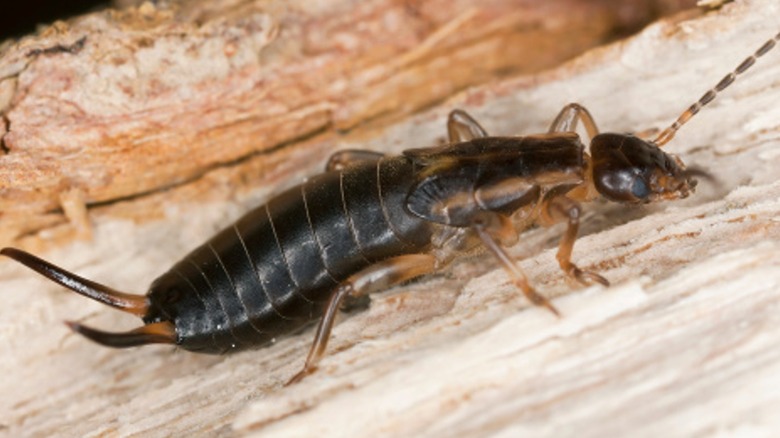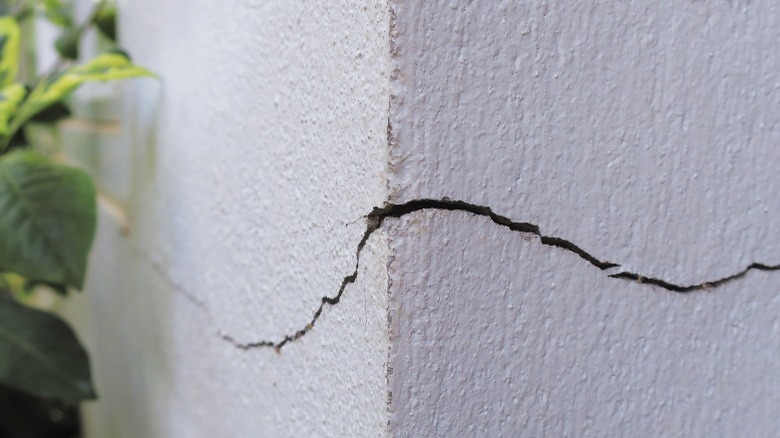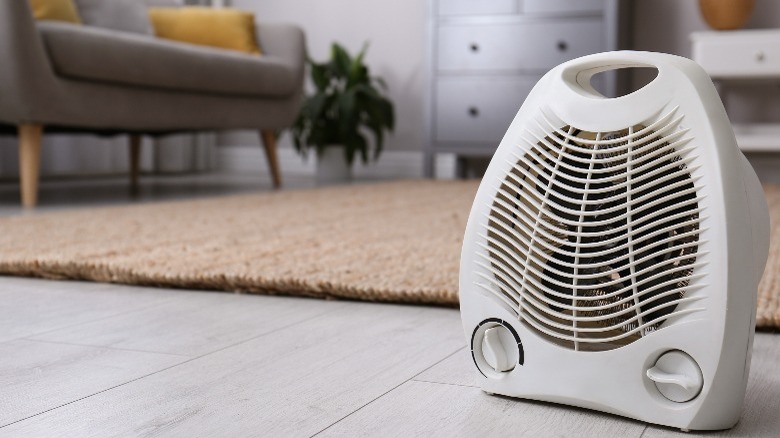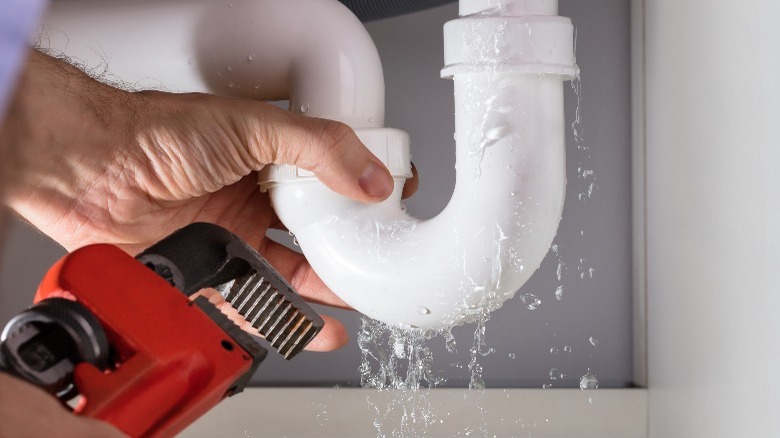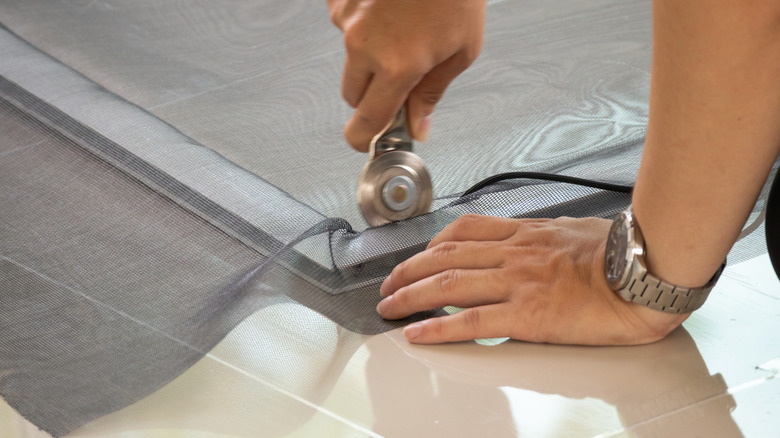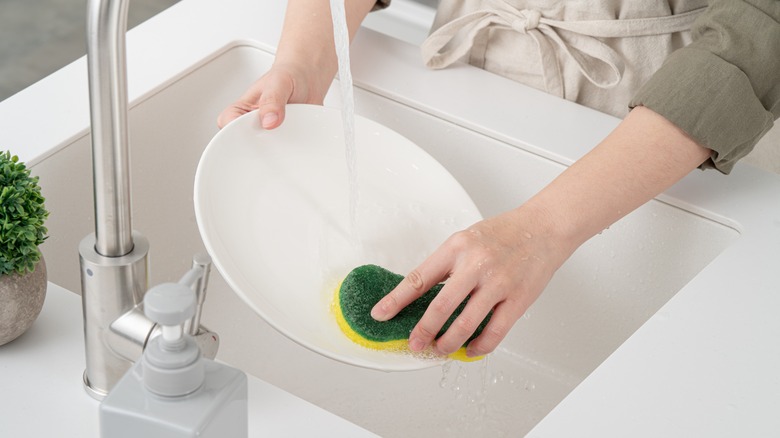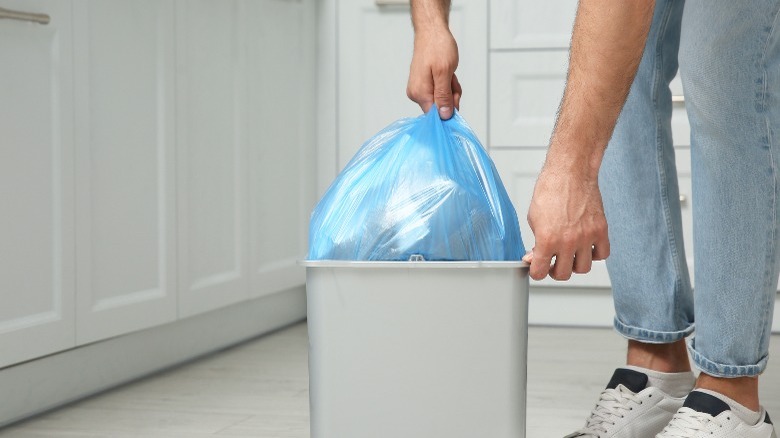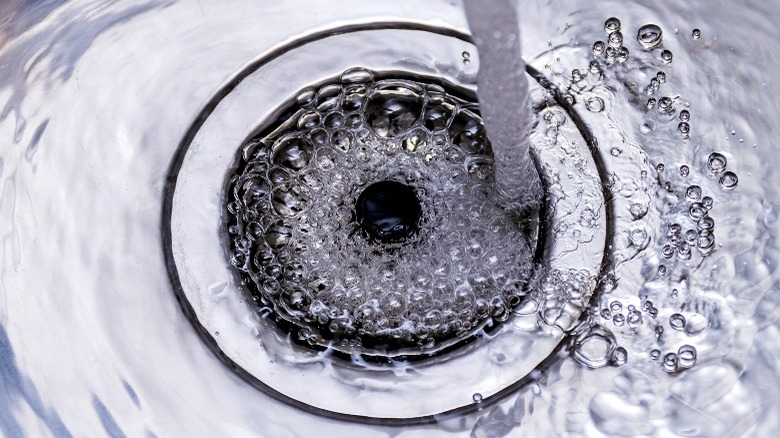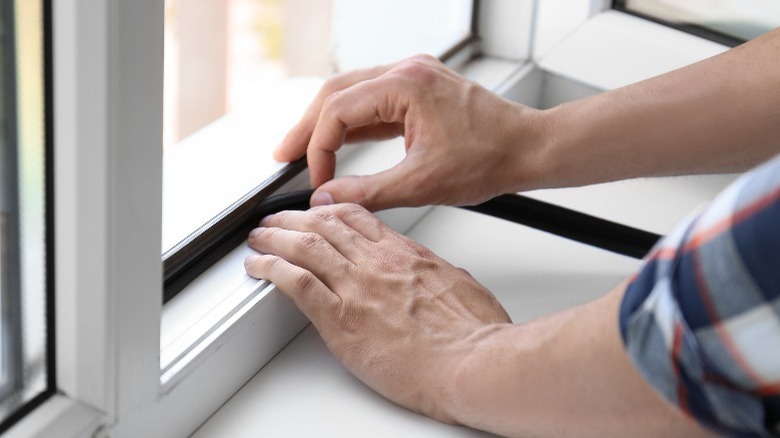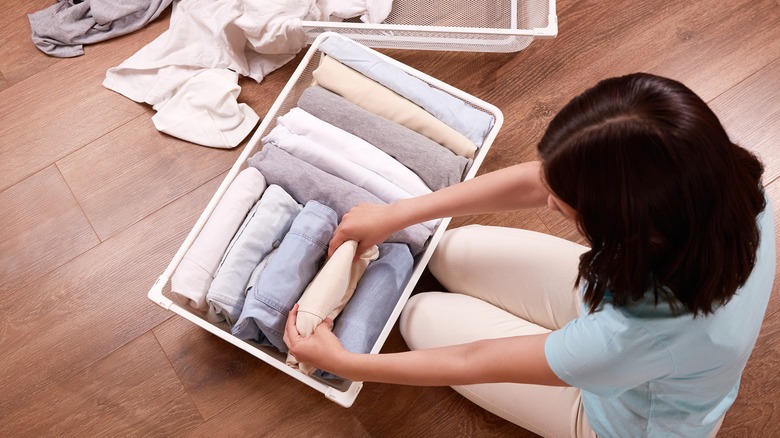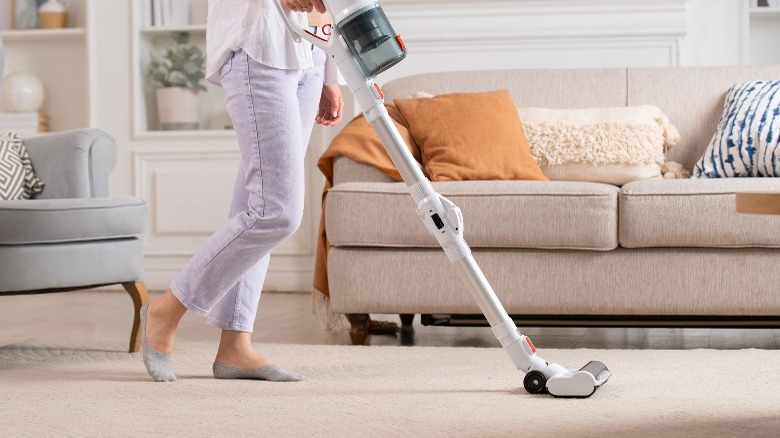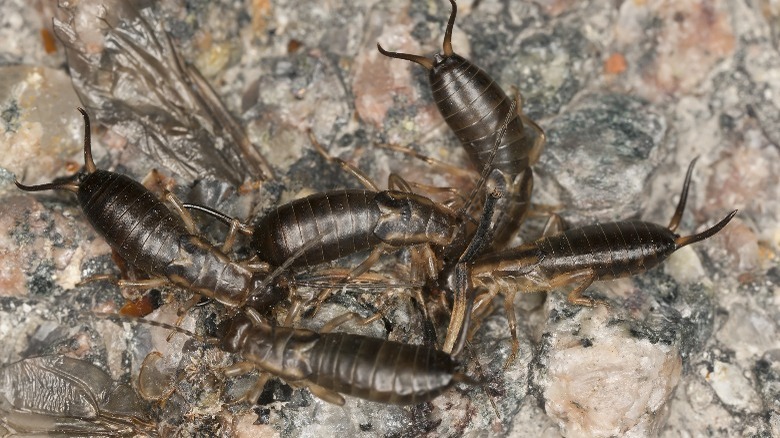Keep Earwigs Out Of Your House With These Tips
Oddly named and creepy-looking, earwigs make their way indoors through various entry points that homeowners might not be aware of. Seeing one in a bathroom sink or bedside night table can be disgusting and frightening, and squashing or trapping and releasing them can be downright gross. Prevention is the smart way to deal with them. And addressing the root causes of these infestations can keep those icky earwigs out of your house.
There's no denying that earwigs are scary looking. They're about an inch long and darkly colored, with slim antennae on their heads and curved pincers on the ends. Earwigs are nuisance pests because even though they're unpleasant to look at, they don't bite or cause significant damage to homes. These insects can pinch when they are threatened, but it doesn't hurt. Earwigs will eat their way through gardens and might get into houseplants, too. And besides plants, earwigs enjoy eating other insects, mold, fruit, and other things that might be left out inside a house.
Earwigs prefer the outdoors but will invade homes when looking for food or seeking shelter. They can flatten out their bodies and squeeze through narrow openings like cracks and crevices when searching for food. Signs of indoor infestation include a brownish-yellow and stinky secretion, earwig carcasses, and dead plants and leaves. Here are some tips for keeping them outside, where they belong.
Seal your foundation
It's wise to check a home's foundation for problems at least once a year because it can serve as an earwig entry point when it has holes, cracks, or gaps. The most common causes of this deterioration are settling soil and moisture, and the cracks can be vertical or horizontal. Concrete also wears out over time, becomes less uniform, and can develop holes that serve as "come on in" signs for earwigs.
Hairline foundation cracks can be addressed with concrete bonding adhesive and a vinyl concrete patching compound. The adhesive liquid can be applied with a paintbrush, then you can use a putty knife to push the compound in. Wider cracks and holes can be cleaned off with a stiff wire brush and rinsed away with water. These should be repaired with latex concrete caulk, silicone, or polyurethane applied with a caulk gun. Cracks and holes bigger than ½ inch need foam backer rods or hydraulic cement, so calling a professional might be the best option.
Use fans and dehumidifiers
Earwigs don't like dry environments so removing as much excess moisture from a home makes them feel unwelcome. Setting up portable fans throughout the house is an option but it can be pretty noisy. Ceiling fans can help but exhaust fans move more air. Bathrooms usually have these built into the ceilings and should be turned on when taking showers and left on for a while afterward to combat the humidity. These generally vent the air out through the roof or exterior wall. Attic inline fans work with a home's ductwork system, and push the air and moisture out that way.
Dehumidifiers process moisture in the air into water that can be disposed of. Check for places in the home that have consistently wet surfaces, discolored wood, and water stains. Then, place dehumidifiers there before the earwigs find out about them, or use portable ones that can be moved around to areas that need to stay drier. Some homes have built-in dehumidifiers that are part of the HVAC systems and there are also wall-mounted tankless, recessed ones that are also sold by retailers.
Repair leaky plumbing
Earwigs are also attracted to high moisture levels around leaking pipes and the most common locations are beneath bathroom and kitchen sinks, under refrigerators and garbage disposals, and kitchen and laundry room appliance waterlines. Sometimes the pipes need to replacement when they are rusted or otherwise unrepairable but in other cases, a quick fix can correct the leak.
Inspect to see where the water is leaking out and if it's a loose coupling nut, tighten it with a wrench. Leaky pipes can also be fixed with self-fusing silicone tape or plumber's tape. Pipe putty can also work, and gets applied over the leak and left to harden. A neoprene patch and repair clamps can be a more permanent fix. Whichever method is used, the water must be shut off first. Then, turn it back on and test it after the repair is made.
The home might have a major leak if there are serious mold and water spots on a wall, floor, or ceiling. Bulging and warped siding are also major red flags indicating moisture. When these happen, an earwig infestation will be relatively minor to the remediation and repairs that need to be completed. This is why it's so important to check for leaks often and fix them right away.
Fix holes in window screens
Window screens are vulnerable to damage from animals and insects chewing through them. They can also fail from being stretched too far, UV rays, storms, and cold weather. Earwigs and other insects that find the holes make the most of them and come through to invade homes.
Window screens are made out of fiberglass or aluminum mesh and once a hole forms, it can quickly widen. The fastest way to fix a small hole in a fiberglass screen is with nail polish. Rearrange the fibers back over the hole and cover it with clear nail polish, give it 15 minutes to dry, and apply a second coat. For larger holes, use an adhesive fiberglass screen patch material and cut a piece that's slightly larger than the hole before applying it. Aluminum screens are easily fixed with aluminum screen patches in much the same way. If there are multiple holes or significant damage, rescreening the frames might be your best bet. Make sure to examine your screen frames as well to ensure there are no gaps around the edges.
Don't leave food or drinks out
An earwig's diet mainly consists of other insects and plant matter but when they get indoors, they'll also feast on flour and things like bread and cookies. They also enjoy digging into fruits and vegetables. It's easy to forget to clean up food, drinks, and dirty dishes or to figure that the cleanup can wait until the next day. But anything left out for too long is fair game for hungry earwigs, and this includes crumbs and spills.
After eating and drinking, store leftovers in sealed containers, wipe down the countertops, and attend to the floors. Rinse off dishware and glasses and put them in the dishwasher or at the very least, leave them to soak in the sink with hot water and soap. And don't forget about pet food and water bowls either, because earwigs aren't picky and will go for those too. Keep the food contained and pick up any stray bits from the floor.
Take out the trash and rinse the can
The golden rule for garbage is simple: Take it out regularly. It doesn't have to happen every day, especially when there isn't any food waste inside. But odors from things like vegetable peels, shrimp shells, and chicken bones attract earwigs. The decaying matter also generates moisture and earwigs like that, too.
To make the trashcan even less appealing for earwigs, use strong, scented liners and clean the garbage can once a week or sooner when it smells or becomes dirty. Clean it in a large kitchen sink or outside with a garden hose. Rinse it out, then add dish detergent and more water, scrubbing it down the inside and outside with a bristled brush. For more cleaning power, add some vinegar or bleach. Once the can is rinsed and dry, sprinkle the inside with baking soda to prevent odors. Don't forget about the recycling cans because those also need to be taken out and cleaned regularly. Be sure to rinse food and drink containers with water before tossing them in too, because clinging residue can be detected by wandering earwigs.
Maintain your drains
Few things are as revolting as witnessing an earwig climb up a drain and into a bathtub or sink. This first drain hack is pretty creepy but it can clue you into the existence of earwigs that might be further down in the pipes. Cover up the drain with strong tape and peel it off the next morning. If there are earwigs stuck to the underside, there could be more of them planning to come up and out.
Earwigs can overtake drains when there's standing water left in sinks or when drains are clogged. It's not possible to keep drains dry, but attending to clogged sinks in a timely matter is doable. When the water isn't draining quickly, combine two parts white vinegar with one part each salt and baking soda. Pour it down the sink and let it sit for 24 hours. The mixture will eat away at the gunk and afterward, it can be flushed with boiling water.
Drain covers can also keep earwigs at bay and are made with holes that are small enough to allow water through but keep these pests out. They protect open drains, prevent clogs, and can be used in bathtubs and sinks. Just be sure to clean these as well, because they can get dirty and clogged from debris like hair and oils.
Seal window frames and doors
Earwigs can sneak in through tiny openings in window frames and if there is air coming into the house, water stains, or peeling paint from these areas, they should be sealed. The culprit could be damaged weather stripping and which is easily replaced. But if that is in good shape, any air gaps around the frame can be filled in with caulk.
Air also comes into homes through the bottoms of doors, and this earwig-friendly path can also be blocked with the right materials. One option is a draft snake, a product used to prevent air from coming in at the bottom of a door. These are usually made from thick material and can be moved around as needed. This can help but is a temporary solution. Similar to a draft snake, door sweeps are more permanent because they are made with flexible tabs or installed with screws. You can also use thick foam tape that comes in a roll and can be cut to fit. But if there's a lot of air getting in, the door might need to be repaired or replaced. When these simple hacks aren't effective enough, it's probably time to grab the toolbox or call a carpenter.
Reduce clutter to eliminate hiding places
Insects like earwigs head toward cluttered areas because of the privacy and protection offered. These are places where they can eat, live, and reproduce, with less fear of detection. Cluttered areas also offer more warmth and if there is moisture, it's like earwig heaven.
To eliminate clutter, start by gathering up piles of dirty laundry and corralling them in hampers. Earwigs might not be quite as attracted to clothes but it's best to do laundry once a week. Clean up piles of paper, closet floors, the insides of cabinets, and anywhere else earwigs might hide. Place the items in sealed storage boxes and label them as needed. They should be stored off the floor, about a foot up off the ground. Don't forget about decluttering the garage and basement, either, as both parts of a home often have moisture problems and can serve as earwig entry points.
Get out the vacuum cleaner
Once the home is decluttered and everything is off the floors, take out the vacuum because earwigs are also drawn to moisture, food particles, and dirt in and on carpets and floors. A good vacuuming will also remove food residue plus insect droppings, insect eggs, carcasses, and other waste that earwigs eat. The vacuum hose attachment can tackle corners and narrow, hard-to-reach areas, so use that to remove debris from the insides of cabinets, the top of the refrigerator, and in back of toilets.
For additional vacuuming power, grab a box of baking soda. Not only will this remove odors and freshen up carpets, but it will also reduce some of the moisture that the earwigs are attracted to. Sprinkle it over the surface of your carpeted areas from wall to wall and let it sit for a few hours, ideally overnight. Then, vacuum thoroughly to reveal fresh, dry fibers.
Check your pets and packages
Some dogs spend considerable time outdoors and this increases the likelihood of them bringing unwanted visitors into a home. Earwigs might attach themselves to dog or cat fur and hitch a ride indoors. In the case that there are several, they could reproduce once inside.
It's always wise to check pets when they come indoors, and keeping them groomed is important, too. Of course, cats prefer to groom themselves, so they may be less likely to have earwigs on them. Earwigs are larger than ticks and fleas but might be covered by fur. A flea comb can be used to check for earwigs, and regular baths are a must. Keep an eye on your pets as when they have insects on them, they tend to scratch themselves often and shake their heads back and forth.
Homeowners who have packages delivered might also be susceptible to indoor earwig infestations, especially when a box was left outside and got wet. Earwigs might hop onto the surfaces or even make their way inside. So always check the outsides of packages before bringing them inside.
Clean up the yard
One of the most effective ways to keep earwigs out of your house is by creating an unwelcoming environment. In this instance, that means cleaning up the yard. The same theory for the inside of a home applies to the outdoors. Eliminate damp, dark hiding areas or relocate them farther away from the house. This includes leaf and firewood piles. Keep these in a far corner of the yard to avoid drawing earwigs, and other pests, closer to the structure.
This can be difficult when a home has mulched garden beds against its outer walls. You can use plastic sheeting covered with sand or rock to make a good barrier around the perimeter. This can keep earwigs out since it won't retain moisture. You can also sprinkle a border of diatomaceous earth around the border of your home. This substance can exterminate the insects before they have a chance to make entry.
Earwigs got into the house, now what!
Earwigs got their scary name because people used to claim that the insects crawled into people's ears and tunneled into their brains. However, this was an old European myth and though they may look frightening, they don't harm people and are no cause for alarm. So instead of freaking out, remain calm and use real science to get rid of them.
An oil pit trap will attract earwigs and catch them. To make one, get an old plastic container with a lid. Punch holes at the top that are large enough for the earwigs to crawl into, and pour in equal parts of vegetable oil and soy sauce up to just under the holes. The earwigs will go in to eat but won't be able to escape. If the oil trap doesn't work, mix up a homemade anti-earwig spray. They can be killed on contact with a mixture of 70 percent rubbing alcohol and water. Mix the simple solution into a spray bottle and spritz it on them. There are also commercial pesticides that can be used but look for ones with labels showing they are effective on earwigs.
